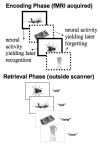Remembering the Details: Effects of Emotion
- PMID: 19421427
- PMCID: PMC2676782
- DOI: 10.1177/1754073908100432
Remembering the Details: Effects of Emotion
Abstract
Though emotion conveys memory benefits, it does not enhance memory equally for all aspects of an experience nor for all types of emotional events. In this review, I outline the behavioral evidence for arousal's focal enhancements of memory and describe the neural processes that may support those focal enhancements. I also present behavioral evidence to suggest that these focal enhancements occur more often for negative experiences than for positive ones. This effect of valence appears to arise because of valence-dependent effects on the neural processes recruited during episodic encoding and retrieval, with negative affect associated with increased engagement of sensory processes and positive affect leading to enhanced recruitment of conceptual processes.
Figures







References
-
- Bahrick LE, Parker JF, Fivush R, Levitt M. The effects of stress on young children’s memory for a natural disaster. Journal of Experimental Psychology: Applied. 1998;4:308–331. - PubMed
-
- Bargh JA, Chaiken S, Govender R, Pratto F. The generality of the attitude activation effect. Journal of Personality and Social Psychology. 1992;62:893–912. - PubMed
-
- Bernstein LJ, Beig S, Siegenthaler AL, Grady CL. The effect of encoding strategy on the neural correlates of memory for faces. Neuropsychologia. 2002;40:86–98. - PubMed
-
- Bless H, Schwarz N. Sufficient and necessary conditions in dual process models: The case of mood and information processing. In: Chaiken S, Trope Y, editors. Dual process theories in social psychology. New York: Guilford Press; 1999. pp. 423–440.
Grants and funding
LinkOut - more resources
Full Text Sources
